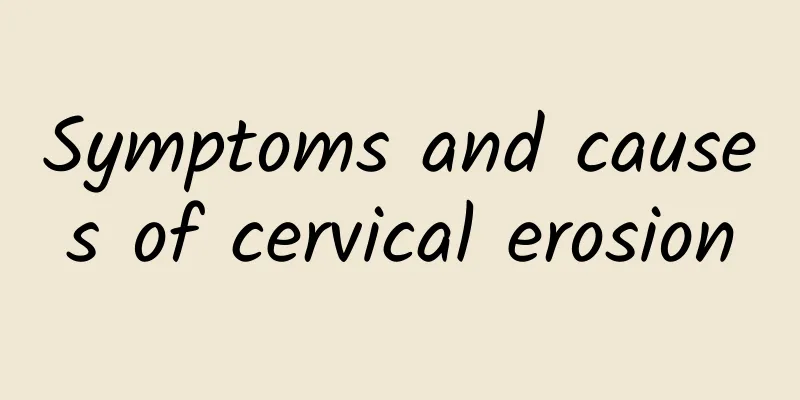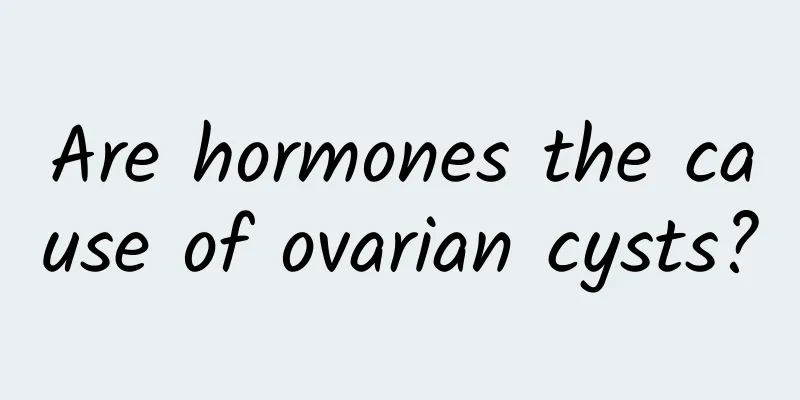Symptoms and causes of cervical erosion

|
Cervical erosion is a common physiological phenomenon on the surface of the cervix. It is not a disease and usually does not require excessive treatment. Its symptoms include increased vaginal discharge and contact bleeding, etc. The causes may be related to factors such as hormone levels and infection. Treatment methods include regular examinations, drug treatment or physical therapy. 1. Common symptoms of cervical erosion The main symptom of cervical erosion is an increase in vaginal discharge, which may be accompanied by an odor or abnormal color. Some women may experience contact bleeding after sexual intercourse, but the amount of bleeding is usually small. A few people may feel discomfort in the lower abdomen or back pain. These symptoms do not necessarily mean cervical erosion, but may also be related to other gynecological diseases, and a gynecological examination is required to confirm the diagnosis. 2. Causes of cervical erosion The occurrence of cervical erosion is related to many factors. Changes in hormone levels are one of the main reasons. In particular, increased estrogen levels may cause the cervical columnar epithelium to migrate outward, forming an erosion-like appearance. Chronic cervicitis, bacterial or viral infections such as HPV infection may also induce or aggravate cervical erosion. Mechanical stimulation such as multiple artificial abortions and childbirth injuries may also cause damage to the cervical surface and form erosion. 3. Treatment of cervical erosion The treatment of cervical erosion needs to be selected according to the specific situation. For patients with no obvious symptoms and no infection, it is usually recommended to conduct regular cervical cytology examinations such as TCT and HPV testing to observe changes in the condition. If accompanied by infection, antibiotics or antiviral drugs such as azithromycin and interferon can be used. For patients with obvious symptoms or large lesions, physical therapy such as laser, freezing or electrocautery can be considered. These methods can effectively remove diseased tissue and promote cervical repair. 4. Daily prevention and care The key to preventing cervical erosion is to maintain good living habits and hygiene habits. Avoid unclean sexual behavior, have regular gynecological examinations, and promptly detect and treat cervical inflammation. Eat more foods rich in vitamins C and E, such as citrus fruits and nuts, to enhance immunity. Avoid frequent use of vaginal douching fluids to avoid disrupting the balance of the vaginal environment. Cervical erosion is a common physiological phenomenon. In most cases, it does not require excessive treatment, but regular checks are required to rule out other potential problems. By understanding its symptoms and causes and taking appropriate treatment and preventive measures, cervical health can be effectively managed. If abnormal symptoms occur, you should seek medical attention in time, get a clear diagnosis and receive targeted treatment. |
<<: Should I remove my ovaries for an ectopic pregnancy?
>>: What are the symptoms of ectopic pregnancy?
Recommend
Black beans are as nutritious as soybeans! The "black bean diet" is popular in Korea and helps to get rid of the big belly
Red beans, mung beans, and soybeans are all beans...
What to do with irregular menstruation? 10 ways to treat irregular menstruation
What should I do if I have irregular menstruation...
How do women know the symptoms of cervical erosion? 5 symptoms of cervical erosion. Know them as early as possible.
Cervical erosion is the most common gynecological...
Four commonly used medical methods for diagnosing cervical erosion
The diagnosis of cervical erosion requires profes...
The "Four Fruits" of Zhongyuan Festival are essential for nutrition and good luck! Rich in enzymes and dietary fiber, it helps digestion and relieves constipation
After the epidemic prevention level was downgrade...
Analysis of surgical treatment methods for benign ovarian cysts
Benign ovarian cysts are a type of ovarian cyst w...
Fight evil vision! Cat back stretching exercise 3 steps to correct hunchback
Do you often feel eye fatigue and discomfort, fee...
What are the things that must be done before abortion?
Many people choose to have an abortion after an u...
Stretch out and refocus after the New Year holiday! Occupational therapists teach you 5 sets of home stretching exercises to keep you safe and healthy
This year's Chinese New Year is quite special...
How long can I go back to work after a miscarriage? Learn the important time points to spend the confinement period
Nowadays, many young women get pregnant unexpecte...
Common causes of vulvar leukoplakia
Some people don't know much about the disease...
Save 640,000 obese schoolchildren: Eat more fruits and vegetables to lose weight and prevent cancer
Being fat as a child is not a blessing! Studies h...
Cervicitis in detail
Are you familiar with cervicitis? If not, then yo...
Will cervical warts be transmitted to family members during the incubation period?
Cervical warts are a sexually transmitted disease...
What is the best dinner for uterine fibroids? What should I pay attention to when eating for uterine fibroids?
What is the best dinner for uterine fibroids? Wha...









